Stirling Engine Key Properties
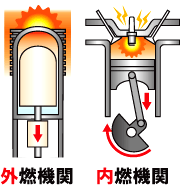
What is "Stirling engine" ? - A Stirling engine is Once heat (high temperature and low temperature) is applied from the outside of the sealed cylinder, piston is moved using expansion and contraction of air (pressure change). It is called in order to apply heat and to move from the outside "an external-combustion engine." The steam engine which runs by coal is also one of the external-combustion engines.
"internal-combustion engine" explodes gasoline and light oil inside an engine, so that we could obtain several energy as electricity, automobile, etc.. An external-combustion engine, generally it does not need to explode fuel, and it operates by heating from the outside. If heat which was not used by the limit of engineering technique which burned various things and were not used until now is also the Stirling engine which has pliability in the design, it can be changed into electric power or kinetic energy.
The feature of Stirling Engine
| No dependency about heat source | The external-combustion engine which works in response to "heat" from the engine exterior. The system which does not choose fuel as an operation unlike the internal-combustion engine which burns fuel and operates inside an engine, but uses various heat sources can be produced. |
|---|---|
| Use of various fuel is possible | 1. Gas (Natural gas, Agricultural residual substance origin biogas ) 2. Oil (Kerosene, heavy, waste oil, inflammable solvent, waste paint, etc...) 3. Biomass 4. Surplus heat of a heat source institution besides an incinerator, unused heat |
| Co-generation | Electricity and warm water can be supplied from heat. |
| More cleaner exhaust gas | Exhaust gas is clean because of Stirling engine is an external-combustion engine. because of the external-combustion engine which does not need an explosion process. very low generating of NOx etc... |
| Silence | Stirling engine operates very calmly, in order to be a low number of rotations and not to generate an explosion. |
We, Promaterials inc is now developing system by Surplus heat use system , and Electricity-generation-by-biomass system , Solar-powered electricity generation, mainly.
Operating principle Description
| General In order to realize "expansion and contraction of the air by heat", a heating head and a cooling unit are before and after the sealed cylinder, and the exchange of the heat by gas or a heat exchanger is performed. A front big piston is "displacer" which divides a hot section and a low-temperature part. A back small piston is a "power piston" which tells power. | 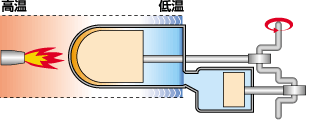 |
| Process 1 If heat is given from the exterior of a cylinder, the pressure of the air which expanded will be added to a power piston, and will depress. Displacer moves and the high temperature side becomes large. Pressure is added to a power piston. | 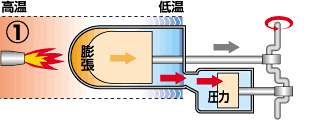 |
| Process 2 If the high temperature side becomes the maximum, temperature will fall. A phase changes and the low temperature side becomes large. (If it becomes a phase in which a power piston goes up, cold air will flow into the hot section which became large through the crevice between displacers) | 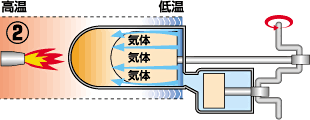 |
| Process 3 Since the hot section was cooled, gaseous contraction takes place, and previously and reverse pressure is added. | 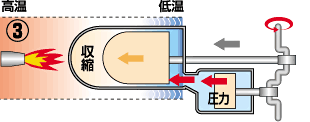 |
| Process 4 To the stage of expansion where a phase will change again and the high temperature side will become large if the low temperature side becomes the maximum. Back to Process 1, again. | 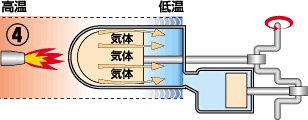 |
